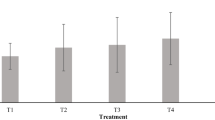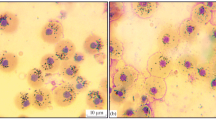Abstract
The oxygen-binding properties of haemolymph from laboratory-reared Artemia franciscana were investigated in vitro. Adult female brine shrimp without eggs were acclimated to seven different combinations of salinity and oxygen. The oxygen affinity (P50) of unprocessed haemolymph rises with acclimation oxygen partial pressure (PO2) up to normoxic values, after which no influence of oxygen occurs. The increase in P50 with acclimation PO2 can be explained by the change in proportion of each of three different haemoglobins in the haemolymph. Salinity acclimation has no effect on haemolymph P50. The effects of the different major salts [NaNO3, NaCl, Ca(NO3)2, Mg(NO3)2], pH, and the metal-binding ligand EGTA on the oxygen-binding properties of buffered haemolymph (of shrimp acclimated to 10‰ salinity) were also studied. Little or no effect of these salts could be found. A small Bohr effect (pH 6.5 to 9.1, ϕ=-0.11) was noted. Addition of EGTA caused a significant decrease of the oxygen affinity at concentrations up to 50 mmoll-1.
Similar content being viewed by others
References
Blust, R., Van Der Linden, A., Verheyen, E., Decleir, W. (1988). Evaluation of microwave heating digestion and graphite furnace atomic absorbtion spectrometry with continuum source background correction for the determination of iron, copper and cadmium in brine shrimp. J. Analyt. Atom. Spectro. 3: 387–393
Bowen, S. T., Lebherz, H. G., Poon, M.-C., Chow, V. H. S., Grigliatti, T. A. (1969). The hemoglobins of Artemia salina-I. Determination of phenotype by genotype and environment. Comp. Biochem. Physiol. 31: 733–747
Croghan, P. C. (1958). The osmotic and ionic regulation of Artemia salina (L.). J. exp. Biol. 35: 219–233
deFur, P. L., Mangum, C. P., Reese, J. E. (1990). Respiratory responses of the blue crab Callinectes sapidus to long-term hypoxia. Biol. Bull. mar. biol. Lab., Woods Hole 178: 46–54
De Wachter, B. (1992) Ecophysiological aspects of the respiratory system of Artemia franciscana. Doctorate Thesis, University of Antwerp, Wilrijk, Belgium
De Wachter, B., Blust, R., Decleir, W. (1992). Oxygen bioavailability and haemoglobins in the brine shrimp Artemia franciscana. Mar. Biol. 113: 193–200
D'Hondt, J., Moens, L., Heip, J., D'Hondt, A., Kondo, M. (1978). Oxygen-bindingcharacteristics of three extracellular haemoglobins of Artemia salina. Biochem. J. 171: 705–710
Everaarts, J. M., Weber, R. E. (1974). Effects of inorganic anions and cations on oxygen binding of haemoglobin from Arenicola marina (polychaeta). Comp. Biochem. Physiol. A 48: 507–520
Heip, J., Moens, L., Kondo, M. (1978a). Effect of concentrations of salt and oxygen on the synthesis of extracellular hemoglobins during development of Artemia salina. Devl. Biol. 63: 247–251
Heip, J., Moens, L., Joniau, M., Kondo, M., (1978b). Ontogenetical studies on extracellular hemoglobins of Artemia salina. Devl. Biol. 64: 73–81
Horne, F. R., Beyenbach, K. W. (1971). Physiological properties of hemoglobin in the branchipod crustacean Triops. Am. J. Physiol. 220(6): 1875–1881
Kobayashi, M., Fujiki, M., Suzuki, T. (1988). Variation in oxygen-binding properties of Daphnia magna hemoglobin. Physiol. Zoöl. 61(5): 415–419
Mangum, C. P. (1990). Recent advances in hemocyanin physiology. In: Préaux, G., Lontie, R. (eds.) Invertebrate dioxygen carriers. Leuven University Press, Leuven, Belgium, p. 449–459
Mangum, C. P., Booth, C. E., deFur, P. L., Heckel, N. A., Oglesby, L. C., Polites, G. (1976). The ionic environment of haemocyanin in Limulus polyphemus. Biol. Bull. mar. biol. Lab., Woods Hole 150: 453–467
Mangum, C. P., Rainer, J. S. (1988). The relationship between subunit composition and O2 binding of blue crab hemocyanin. Biol. Bull. mar. biol. Lab., Woods Hole 174: 77–82
Mangum, C. P., Shick, J. M. (1972). The pH of body fluids of marine invertebrates. Comp. Biochem. Physiol. A 42: 693–697
Mason, R. P., Mangum, C. P., Godette, G. (1983). The influence of inorganic ions and acclimation salinity on hemocyanin-oxygen binding in the blue crab Callinectes sapidus. Biol. Bull. mar. biol. Lab., Woods Hole 164: 104–123
Moens, L. (1981). De extracellulaire hemoglobines van Artemia sp.: een biochemische en ontogenetische studie. Universitaire Instelling Antwerpen. Verhandeling voorgelegd aan de Koninklijke Academie voor Wetenschappen, Letteren en Schone Kunsten van België, Antwerp
Moens, L., Kondo, M. (1976). The structure of Artemia salina haemoglobins. Eur. J. Biochem. 67: 397–402
Morris, S., Taylor, A. C., Bridges, C. (1988). Response of haemolymph oxygen affinity to simultaneous salinity and oxygen stress in the intertidal prawn, Palaemon elegans (RATHKE). Comp. Biochem. Physiol. A 90(1): 31–39
Post, F. J. (1981). Microbiology of the Great Salt Lake northern arm. Hydrobiologia 81: 59–69
Sick, H., Gersonde, K. (1969). Method for continuous registration of O2-binding curves of hemoproteins by means of a diffusion chamber. Analyt. Biochem. 32: 362–376
Torensma, R., Brix, O. (1981). Oxygen binding of Neptunea antigua hemocyanin, the significance of allosteric ligands. Molec. Physiol. 1: 213–221
Truchot, J. P. (1975). Factors controlling the in vitro and in vivo oxygen affinity of the haemocyanin in the crab Carcinus maenas (L.). Respir. Physiol. 24: 173–189
Van Den Branden, C., D'Hondt, J., Moens, L., Decleir, W. (1978). Functional properties of the hemoglobins of Artemia salina L. — Comp. Biochem. Physiol. A 60(2): 185–187
van Holde, K. E., Miller, K. I. (1982). Haemocyanins. Q. Rev. Biophys. 15(1): 1–129
Vos, J., Bernaerts, F., Gabriels, I., Decleir, W. (1979). Aerobic and anaerobic respiration of adult Artemia salina L. acclimated to different oxygen concentrations. Comp. Biochem. Physiol. A 62: 545–548
Weber, R. (1981). Cationic control of O2 affinity in lugworm erythrocruorin. Nature, Lond. 292: 386–387
Weber, R. E., Olsen, L. F. (1984). Does macromolecular surface pH explain the cation dependence of erythrocruorin oxygen affinity? Molec. Physiol. 6: 1–8
Wolf, G., Vanpachtebeke, M., Hens, F., Decleir, W., Moens, L., Van Hauwaert, M.-L. (1987). Study of the oxygen binding properties of Artemia hemoglobins. In: Decleir, W., Moens, L., Slegers, H., Jaspers, E., Sorgeloos, P. (eds.) Artemia research and its applications, Vol. 2. Physiology, biochemistry, molecular biology. Universa Press, Wetteren, Belgium, p. 221–230
Author information
Authors and Affiliations
Additional information
Communicated by R. J. Thompson, St. John's
Rights and permissions
About this article
Cite this article
De Wachter, B., Van Den Abbeele, J. & Wolf, G. Effect of oxygen and salt on haemolymph oxygen binding in the brine shrimp Artemia franciscana . Marine Biology 118, 263–269 (1994). https://doi.org/10.1007/BF00349793
Received:
Accepted:
Issue Date:
DOI: https://doi.org/10.1007/BF00349793




